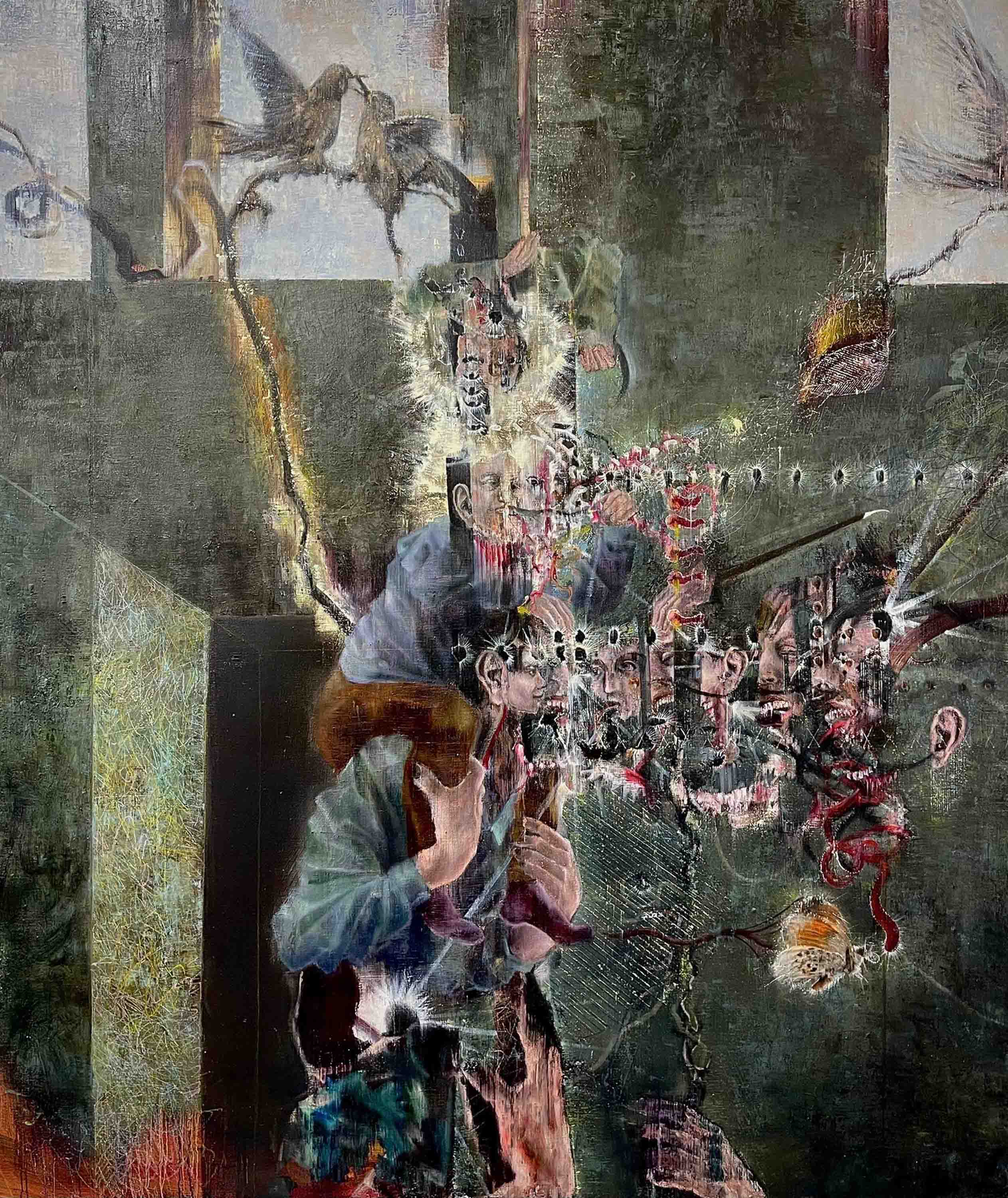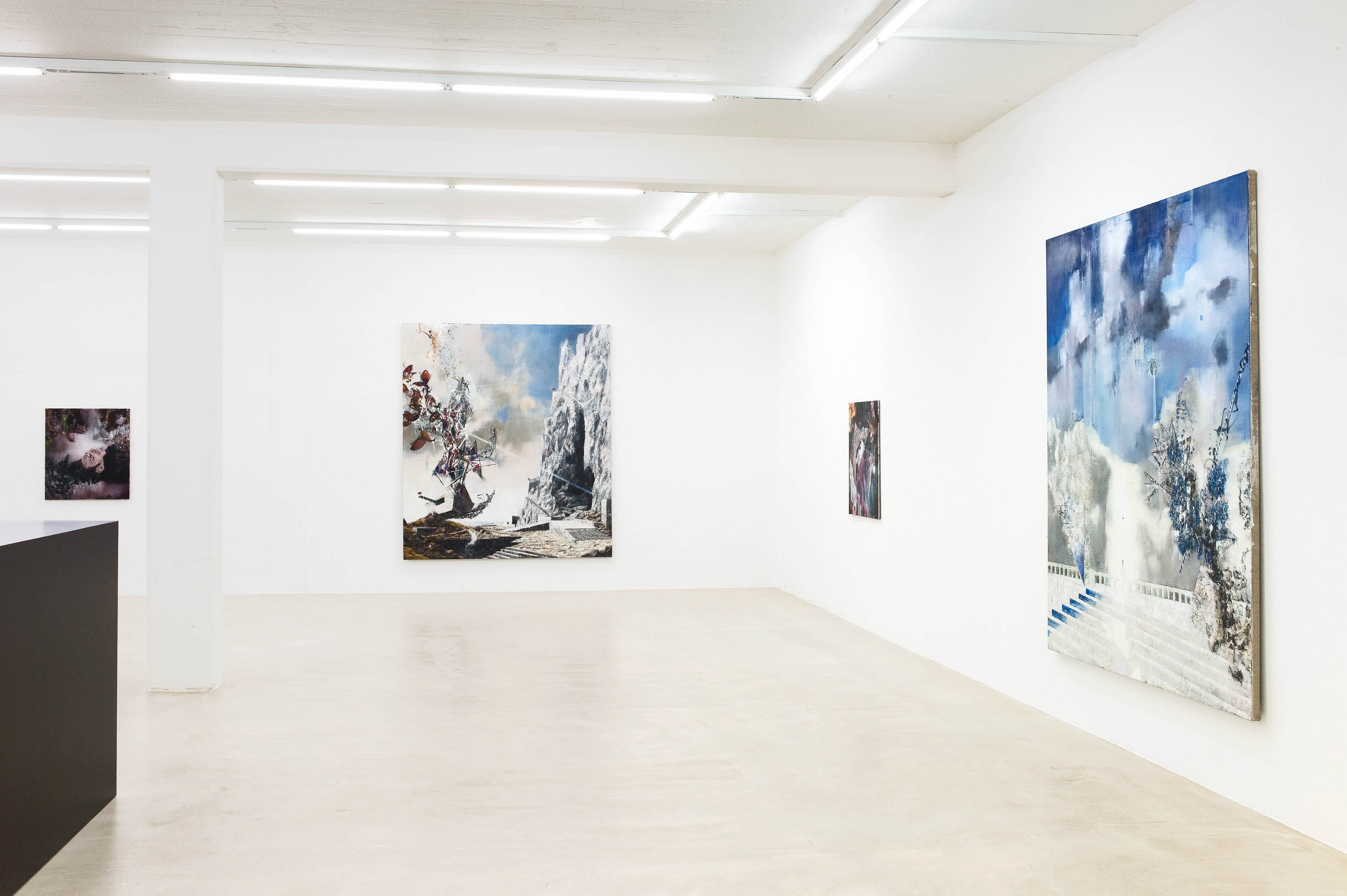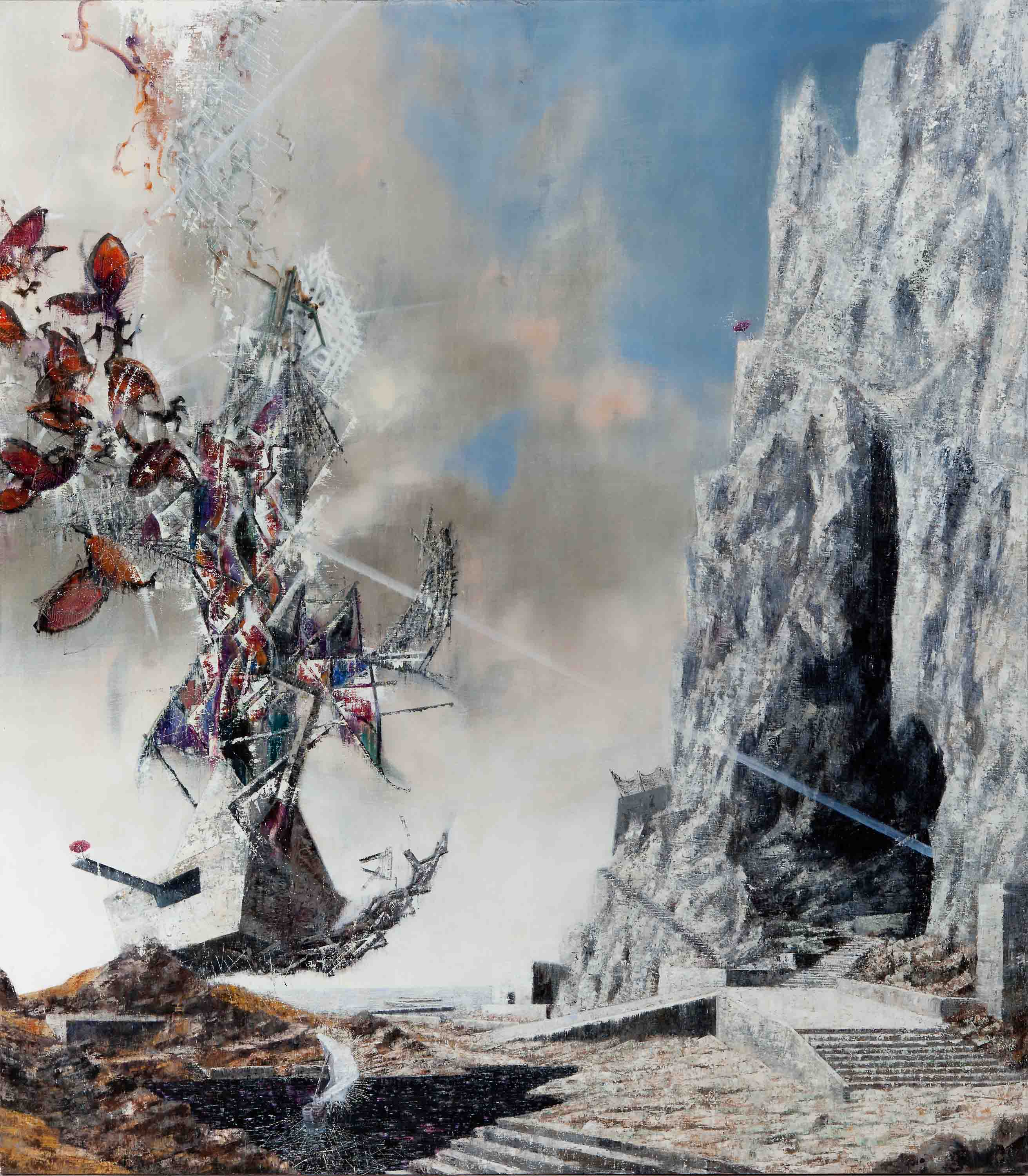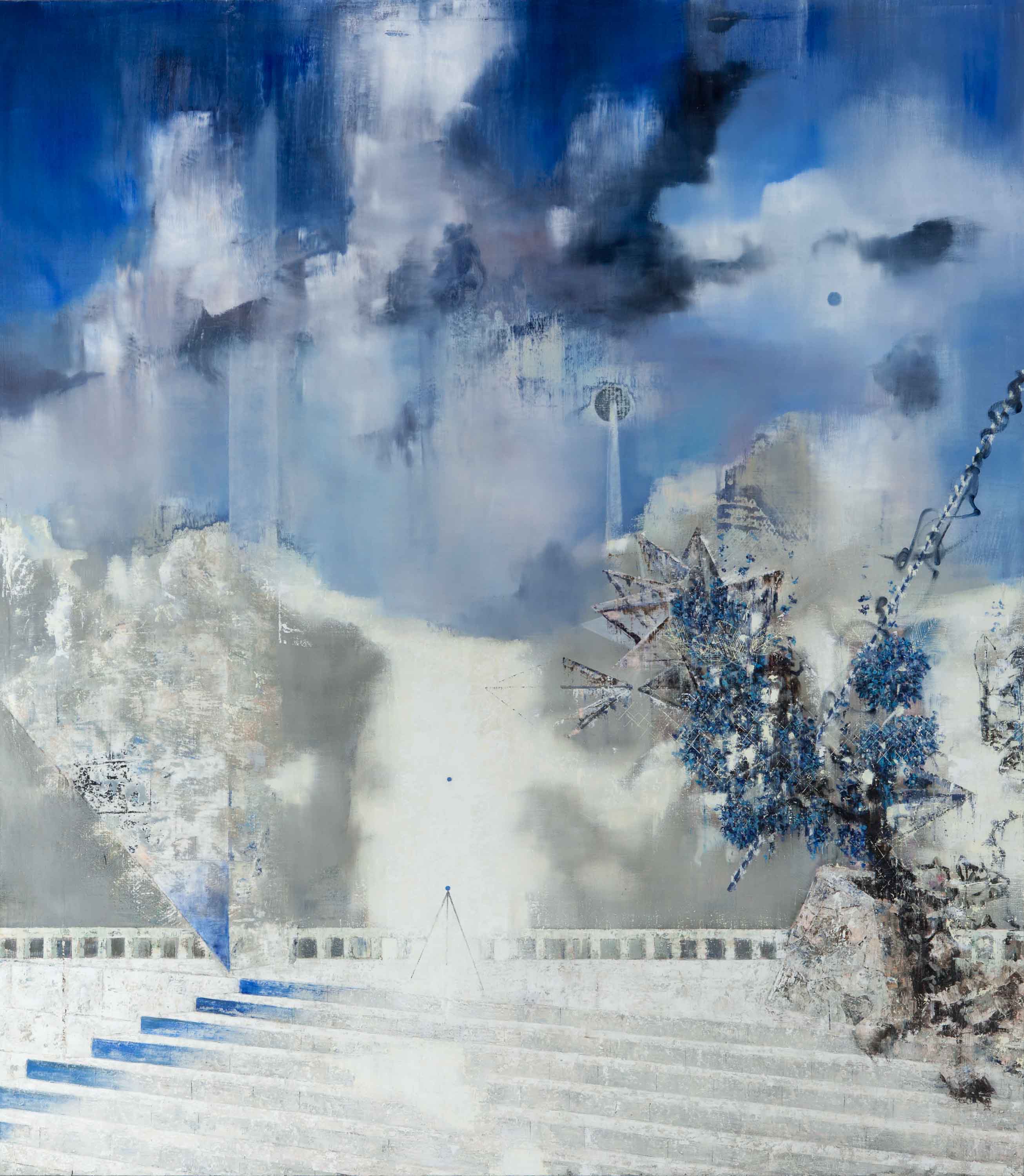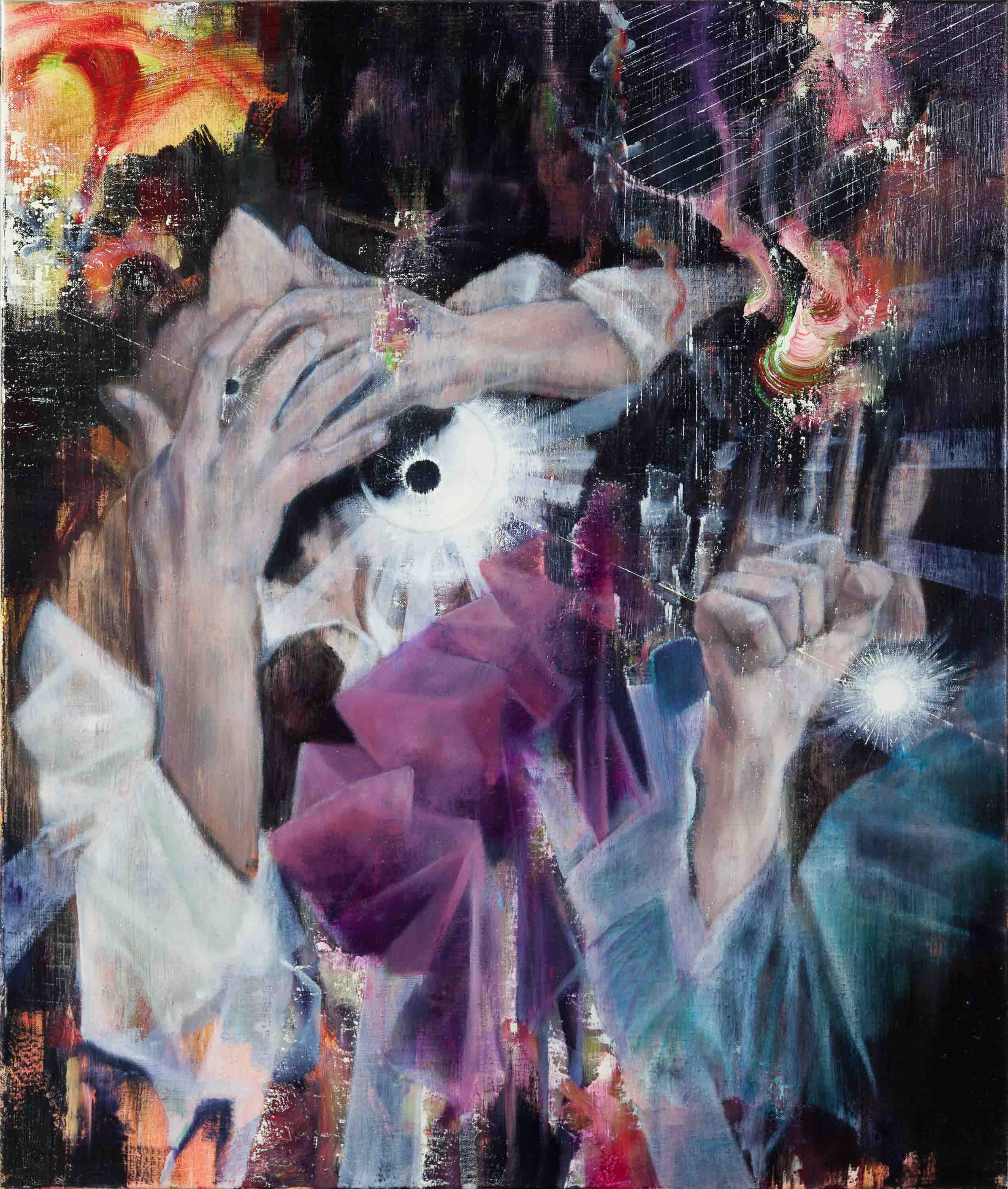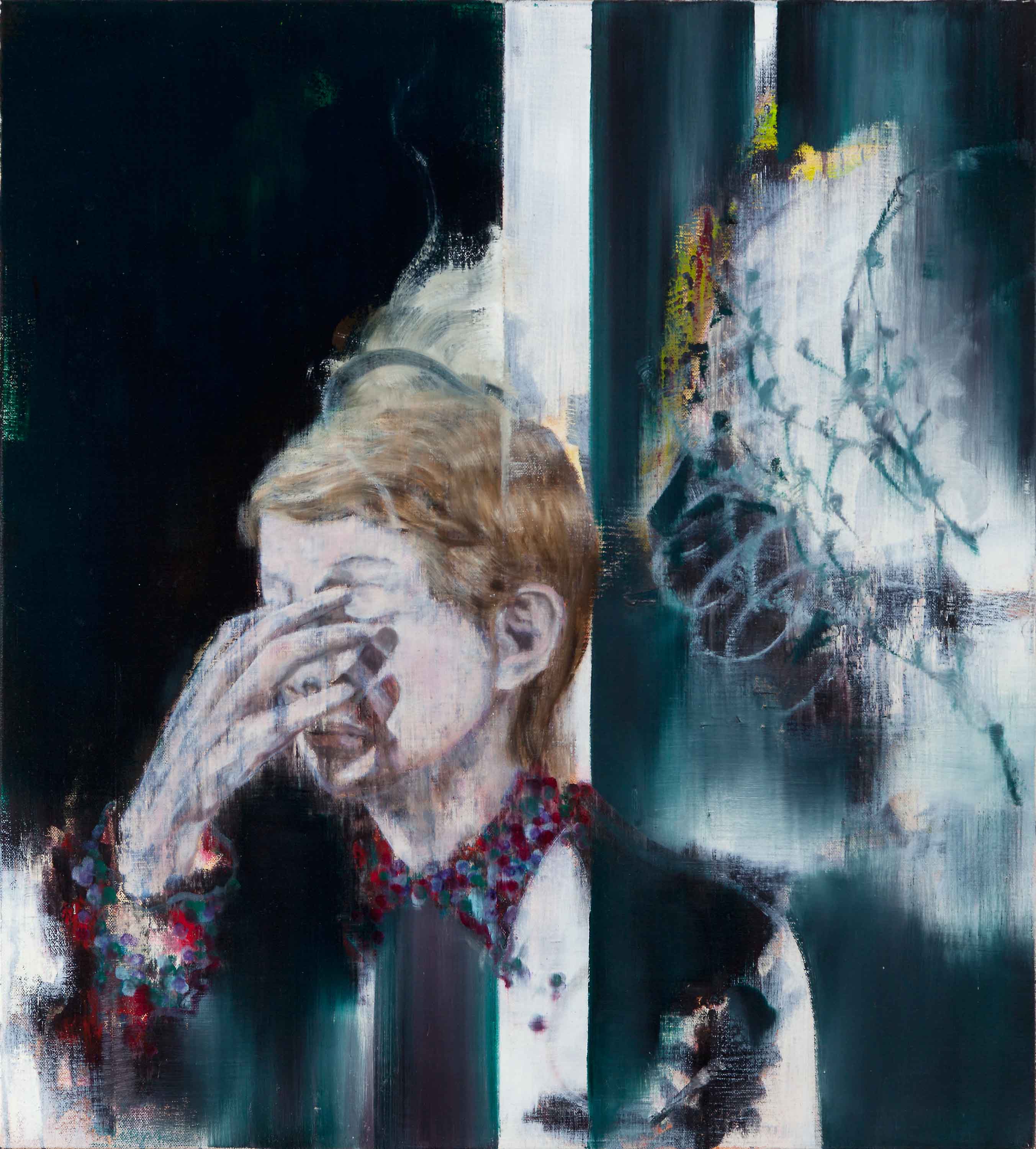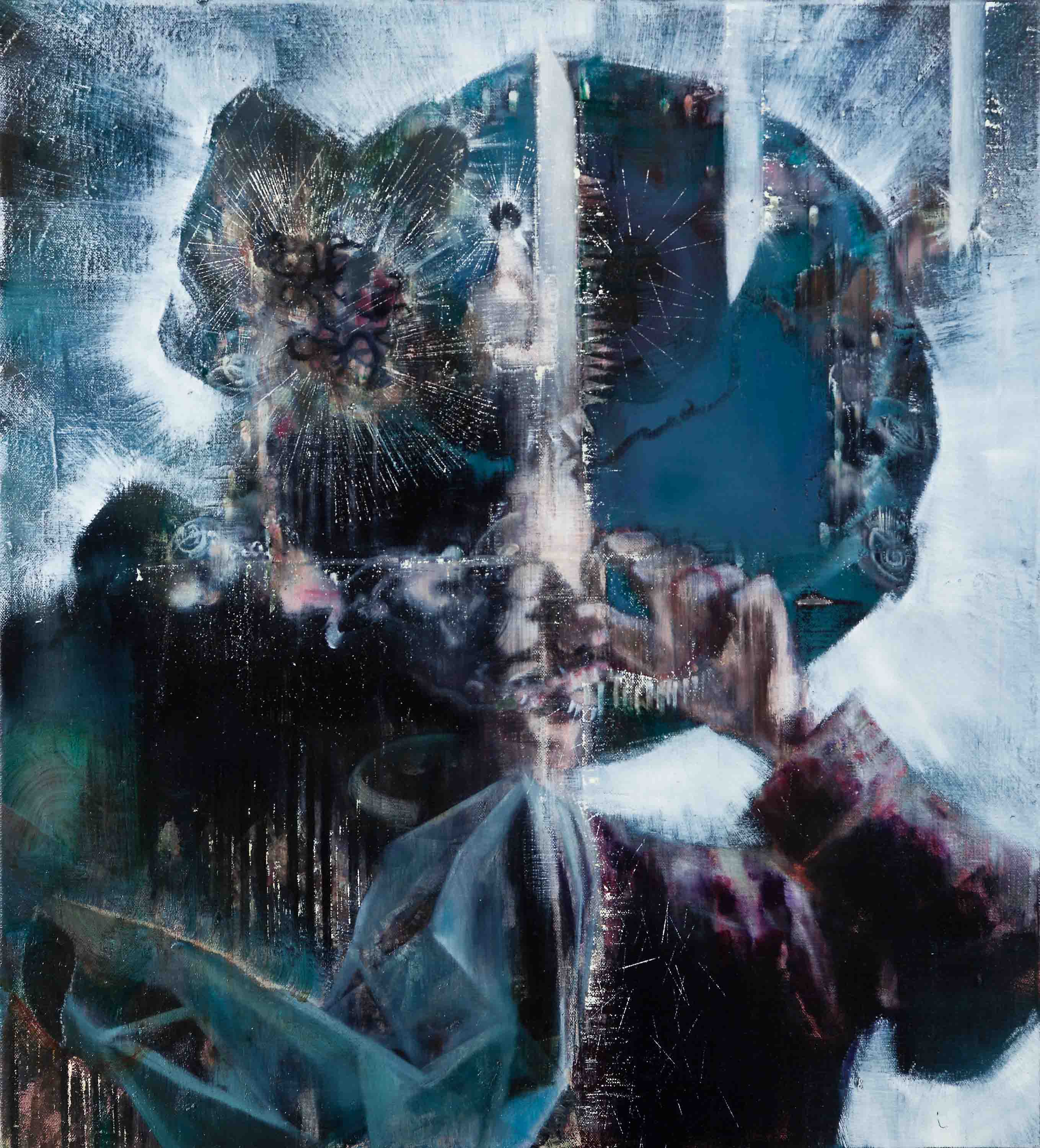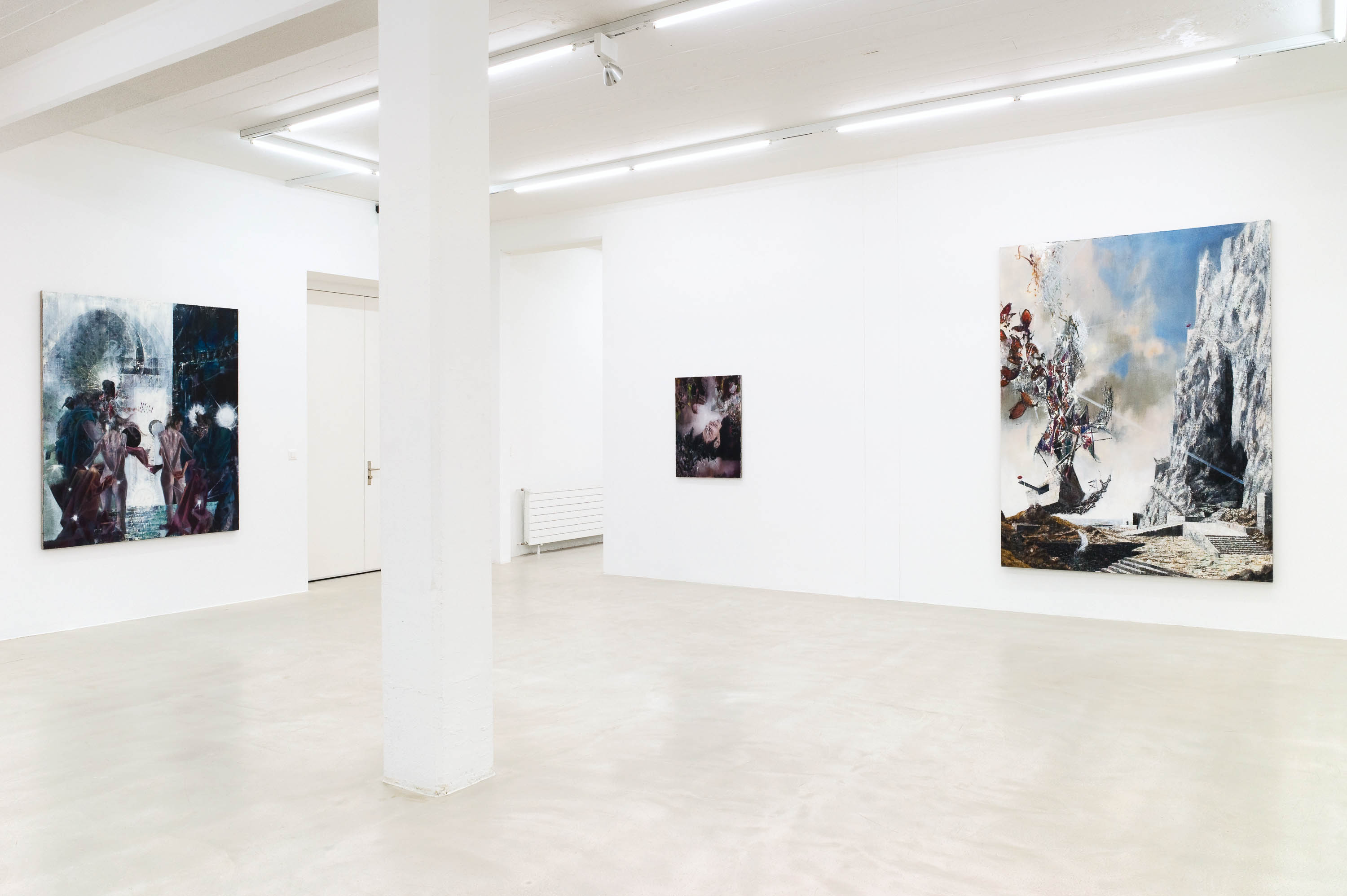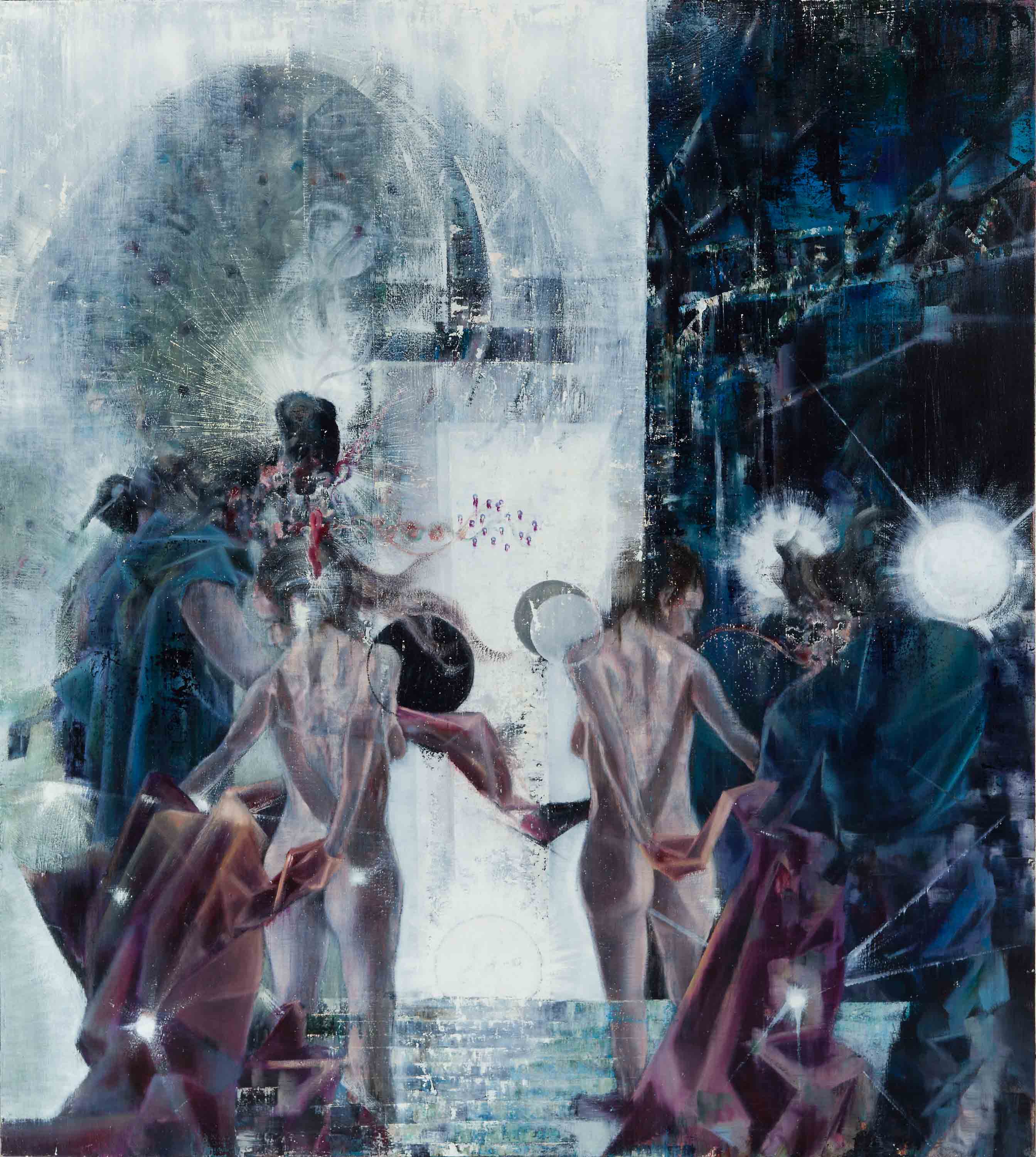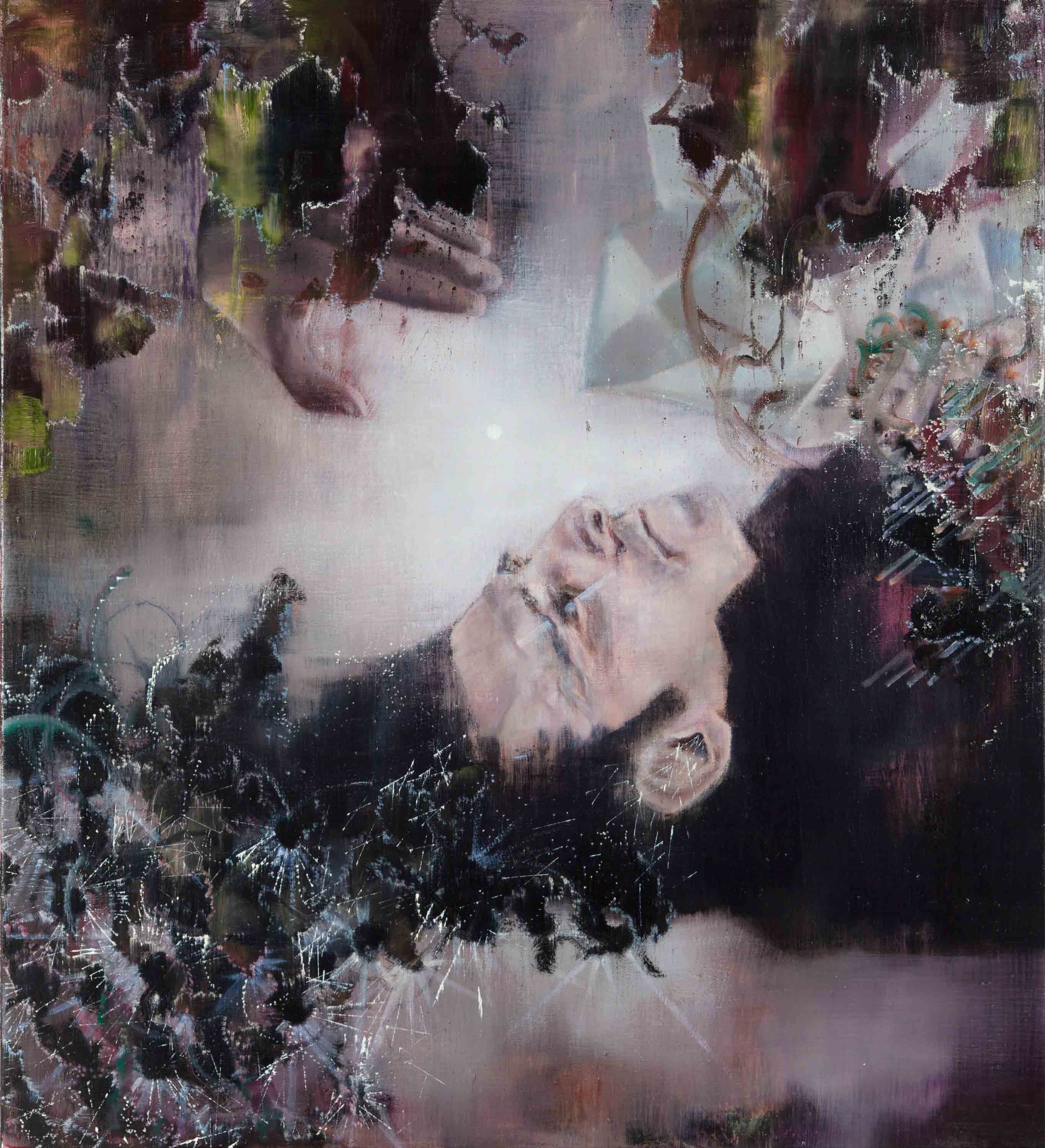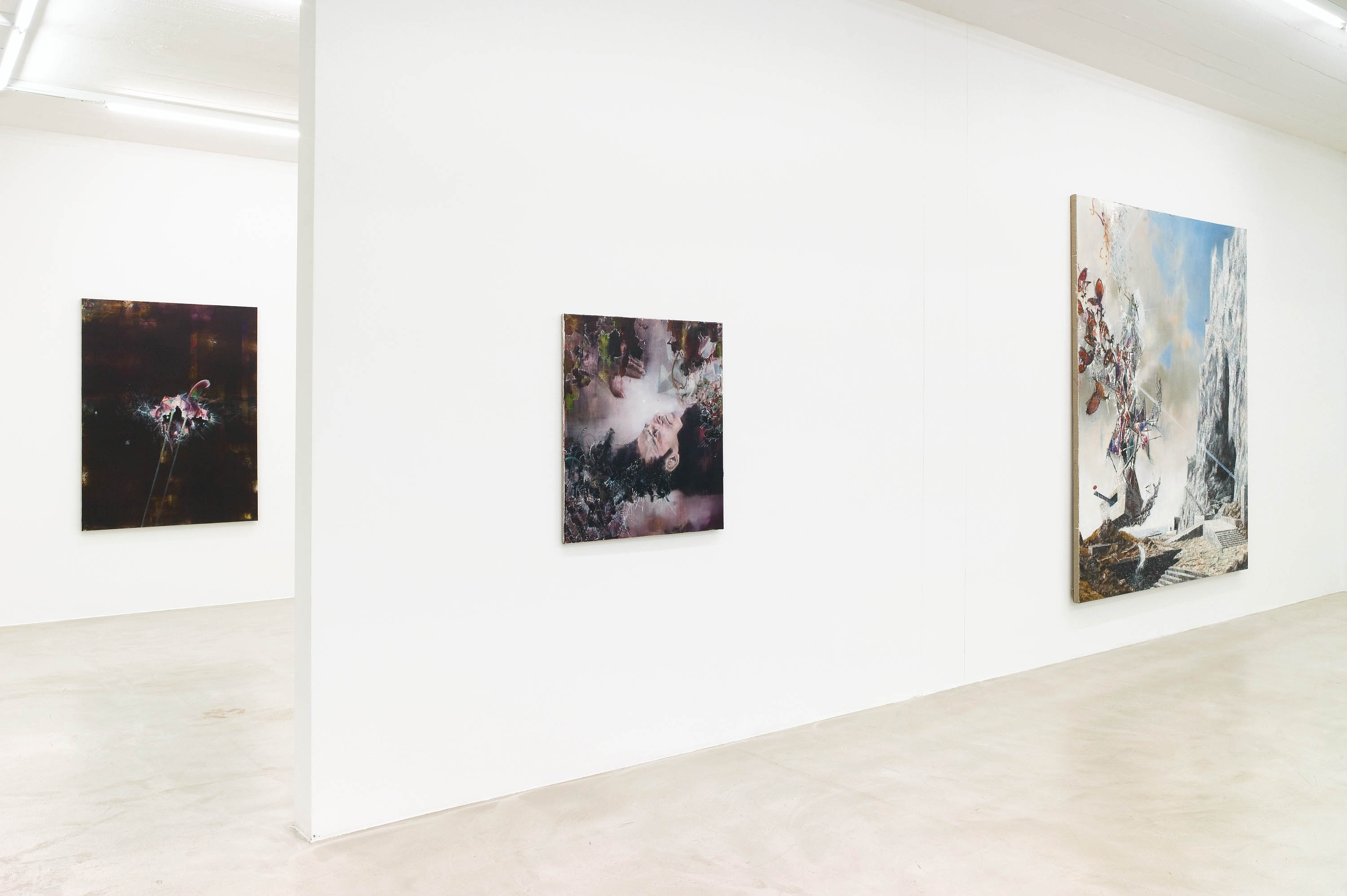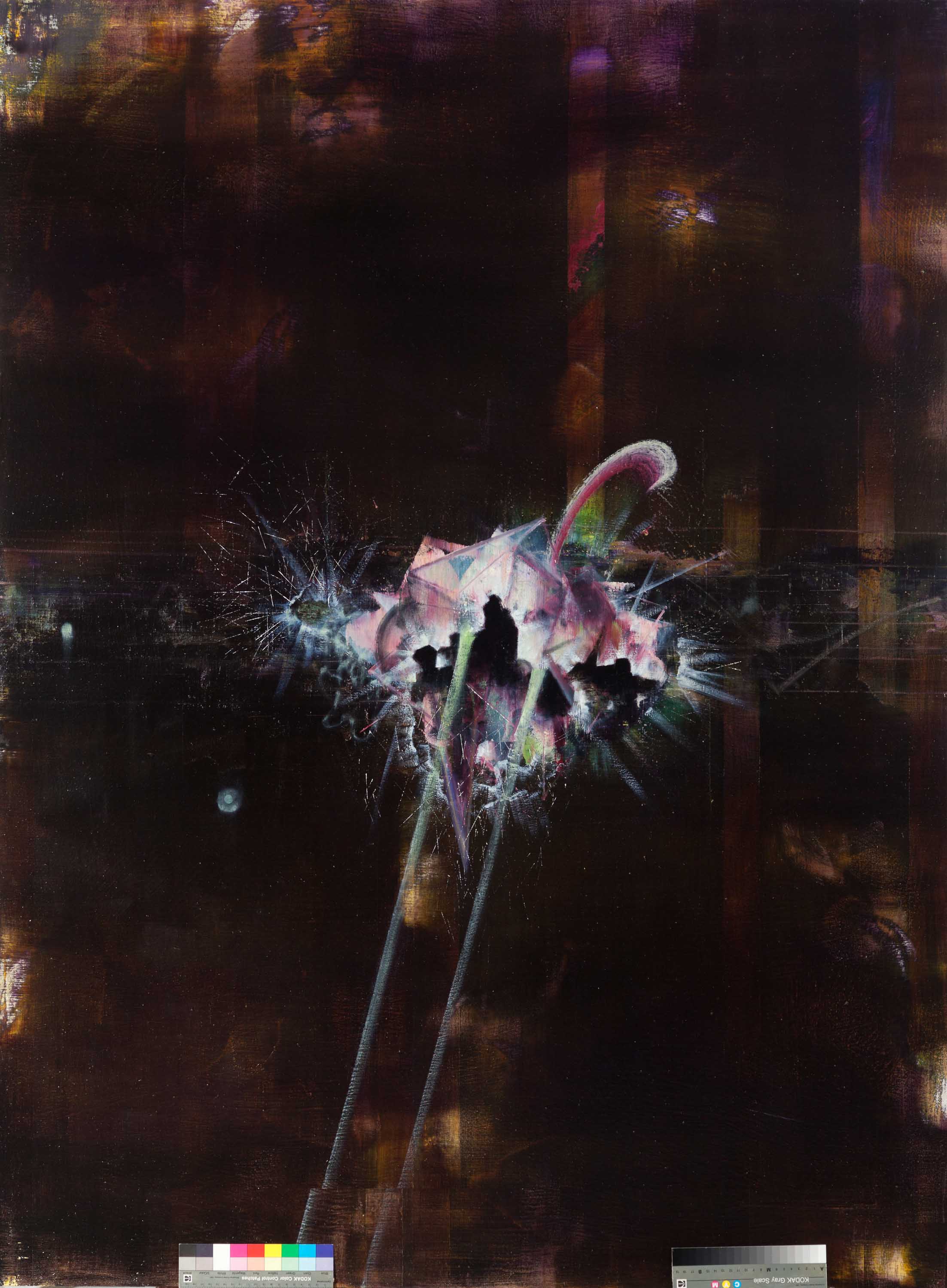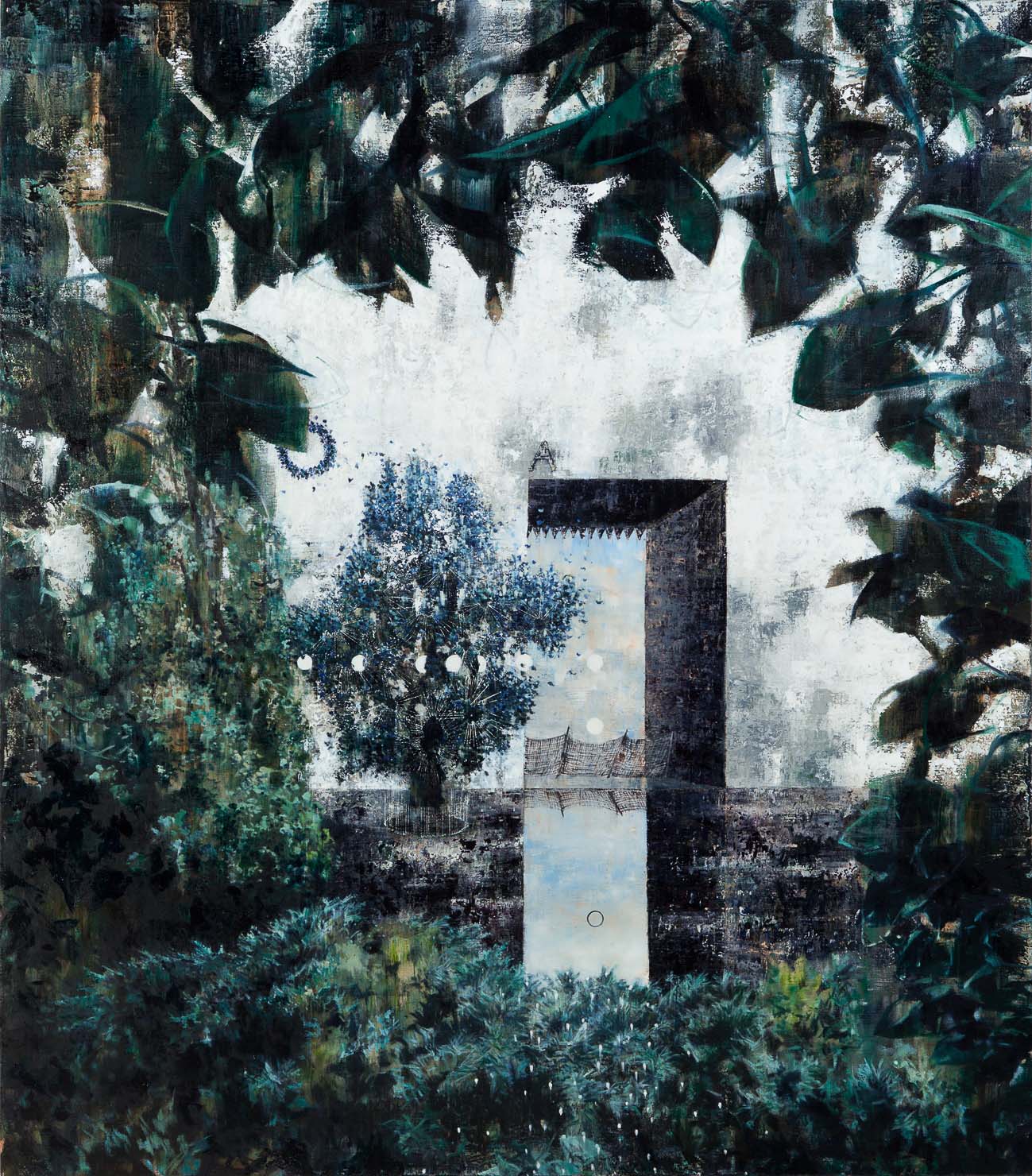- Dates30 April 2015 - 27 June 2015
- Artists
by Michael Kunze
I. LES MESSIEURS D’AVIGNON
Les Messieurs d’Avignon is a collection of modernism’s bad boys ranging from Nietzsche to Houellebecq. What they have in common is the fact that they questioned the one or other 20th-century worldview and self-conception that over time had gained official recognition from a prominent position off on the sidelines. Randomly targeted. In its permanent contradiction to a model of progress that ostensibly proceeds stringently, it marks the loops and interferences of a text that requires revision.
Picasso’s 1907 “Demoiselles d’Avignon” as an icon of early modernism is the starting point for such a text that is in urgent need of correction. Beyond the Cubist analysis of the female body in sunlight, it is conspicuous that there is an absence of the men who reference one of modernism’s shadow lines, the protagonists of which continued a labyrinthine, myth-like continental European pictorial and intellectual concept in which all logical or pragmatic understandings contain an inaccessible core. There is naturally no political correctness on this shadow line, no total social solutions, no common sense pragmatism and no reliable morals. The treasure chest of images and ideas by these authors, which are not entertaining, not informative and are by Anglo- American standards difficult to exploit, describes a horizon that gains in significance today as the model of a modernity beyond Karl Marx and Coca-Cola.
II. AFTER TSALAL
The decisive concluding sequence of Jean-Luc Godard’s 1963 film “Le Mépris” (Contempt) takes place on the roof of the Casa Malaparte on Capri. The architectural icon that makes it possible to adventurously bridge the gap between Arnold Böcklin’s mythic Isle of the Dead and a futuristic, deconstructivist aesthetic draft, looms bizarrely over the period of the 20th century’s ideological conflicts: the eccentric poet Malaparte, who was initially close to Mussolini, later converted to Communism and attempted to bequeath the villa to the People’s Republic of China, which in the end was thwarted after a legal dispute lasting many years. As a “film within a film”, Godard’s “Contempt” is about an American production company and a European director (played by Fritz Lang) shooting Homer’s Odyssey on the roof of the villa.
The thematic of the confrontation between cultural spheres (the theme of antiquity as opposed to a modern format, American “entertainment” as opposed to “serious” continental European art) broached here becomes the creative hotbed for a different and less conciliatory cultural collision: in E. A. Poe’s fabricated seafarer’s journal “The Narrative of Arthur Gordon Pym of Nantucket” (1838), a desperate reciprocal massacre between cultures encountering each other occurs in the Antarctic on the fictitious island of Tsalal – which is perhaps no further away from Böcklin’s Isle of the Dead than Capri. It concerns a reverberation of European colonial history, but maybe also a remnant of the background melody from Fritz Lang’s Odyssey in Godard’s “Contempt” – while Brigitte Bardot is killed in an automobile accident on a country road together with the American film producer.
III. WHAT IS METAPHYSICS?/SPIEGEL INTERVIEW
The so-called “Spiegel Interview” between Rudolf Augstein and Martin Heidegger took place on 23 September 1966. Heidegger’s condition for taking part in the interview was that it first be published after his death. It ultimately appeared under the title “Only a God Can Save” in the 31 May 1976 issue of the magazine “Der Spiegel”. The interview is a document of the inability of two generations to communicate with each other. Where Augstein inquired about historical entanglements, Heidegger responded with metaphysical ponderings. This unbridgeable gap, as well as the death of the protagonist that was negotiated in advance, appears to be voluntarily and involuntarily linked to the discussion of “annihilating Nothingness” from Heidegger’s inaugural lecture “What is Metaphysics” held on 24 July 1929, at the University of Freiburg. The link supplies a gloaming of the overlapping legibilities of text and image: the apparent encounter that takes place between rigid gestures at a round table of spirits in the darkened interior of a knowledge that can only be transmitted by way of parables. The wine glass in front on the desk shimmers back and forth in the last rays of light between lost boundaries. For all the plays of reflections present here, nobody notices whether the invisible hand of the nihilistic wanderer is raising a cup of hemlock or whether a vitreous dancer on the philosopher’s papers loses her final superfluous layer of clothing.
IV. WHAT IS METAPHYSICS?/KINGDOM
The main title for the ensemble of pictures called “What is Metaphysics?/Kingdom” references the round table of spirits that came about in conjunction with the 1966 conversation between Rudolf Augstein, the editor-in-chief and publisher of “Der Spiegel”, and Martin Heidegger (“What is Metaphysics?/ Spiegel Interview”). Martin Heidegger’s condition for taking part in the interview, namely that it first be published after his death (1976), set diverse spirits free. These include calculable and incalculable ones. The incalculable might for example include those that Lars von Trier gathered together in a grotesque hospital for his 1994 television series “The Kingdom”. “The Kingdom” appeared to be Europe’s answer to David Lynch’s “Twin Peaks”.
The abysses that open up behind the physically describable world do not lead to philosophy, but to a gloomy world of madness instead in which the comic and the monstrous are parallel to each other. Only two employees with Down’s syndrome, who work in a dark kitchen space in the hospital’s basement, know something about the uncanny goings-on that are enmeshing physicians and patients in a dense net of real and unreal moments. Lars von Trier links his production to a northern European tradition that includes Ibsen, Strindberg, Hamsun, Berman, etc. that represents a psychologically unfathomable variation of continental European culture in which a textually entwined spirit is at work that is guided less by a stringently chronological plot development than by complex undercurrents.
In the hospital’s nocturnal kitchen as well as in the darkened philosophical library, spirits are trying to figure out a disturbed world in which light can only deliver the promised knowledge if it does not dispel the spirits.
V. RUPERT’S WORDS
In Alfred Hitchcock’s 1948 film “Rope”, a conversation takes place between the philosophy teacher Rupert and the other dinner guests about Friedrich Nietzsche’s ambiguously seductive moral philosophy: because the laws of morality are only valid for the “average person”, a murder for murder’s sake, i.e. the ultimate immoral act, would have to be the ideal instrument of demonstrating a privileged individual’s cultural superiority. Nietzsche is naturally misinterpreted in this mix-up of the aesthetic and the ethic spheres. Nevertheless, or perhaps because of this, the short-circuited analogy of an artwork for an artwork’s sake inspires the murderer and his helper to act: the corpse of the friend who was otherwise also invited as a guest to the dinner party and had been murdered without motive, has been lying all evening in a chest on which plates and food had been placed. Just as the perfect murder is an expression of an absolute free will to create the perfect work of art, the party taking place after the murder with all of the victim’s friends is “the artist’s signature”.
But the philosophy teacher turns into a detective over the course of the evening and discovers the murderer. He points in the process to the borderline of a reality in which the words concerning autonomy, freedom and sublimity are no longer valid. He seems, however, to be contradicting himself as well as Nietzsche’s misunderstood thesis, which in any case has long evaporated in the evening small talk on a parenthetically glossed-over abyss.
VI. IRAS
IRAS, the “International Republic for Artists and Scientists”, is the utopian refuge for the elite from the world of art and science after the nuclear devastation of the earth in World War III. This gloomy science fiction vision dating from the time of the Cold War in the 1950s derives from Arno Schmidt’s novel “Die Gelehrtenrepublik” (1957) (English edition “The Egghead Republic”, 1979). While the conflict between East and West has, of course, in the meanwhile vanished into the thin air of a pragmatic global consumerism, The Egghead Republic remains where it always has been, holding on only to its memories – on an island swimming in the midst of a humanity lost in a frenzy of self-destruction.
A) IRAS/300
A reflection of such memory takes place for example on the occasion of the movie “300” (2006), by Zack Snyder, based on the comic series by Frank Miller. With its martial aesthetics and choreography that are taken up from the comics, a wild gap is bridged between Leni Riefenstahl and the excesses of the fantasy splatter genre from the 1970s, whereby attention is focused on one of modernism’s most difficult, densely ramified but nevertheless crucial byways: heroism in battle and self-sacrifice, both frowned upon in post-war Europe, hibernated in the esoteric format. The legendary Battle of Thermopylae, during which a small number (300?) of courageous Spartans held back the superior and overpowering forces of the invading Persian army, was one of the decisive turning points in the history of the world that would lead to the development of an occidental culture that now plays a determinative role all around the world.
The movie – which was filmed during the highpoint of the American Afghanistan campaign – depicts the Persians with some general similarities to the Taliban warriors, thus creating an analogy to a renewed defence of the West against the onslaught of barbarians from the East. The controversy triggered by this parable is all too familiar to the inhabitants of IRAS: it is impossible to know who the real enemy is when everybody has long been fighting everybody else in the face of an omnipotent threat from all sides.
B) IRAS/REFLECTION
Memory can conceivably lead back to the beginnings of a modernism that simultaneously represents the far side of these beginnings, a leap over the nihilistic obstacle that forms the acid test of the age of autonomies. The viewer is thus transferred to the fantastic site of an occurrence, the constructedness of which forces image and word into the allegoric: there is a link to classical antiquity in Goethe’s “Faust II”, which was staged for the first time unabridged by Peter Stein at Expo 2000 in Hannover, that intends in retrospect to give the story the sense of a definitive universal parable. The cosmological boundary demarcations that transform the “classic Walpurgis Night” scene into an absolute celebration of poetry, while the following marriage between the Faust of “modernism” and the Helena of “antiquity” attempts a historical conciliation and rounding off that wishes to include the whole of the future within itself. The attempt to halt and annul history in antithetical concentration appears to stave off and anticipate modernism’s utopian trauma. The apocalyptic proximity to the best of all possible worlds now shows itself as the undertone of every expelled accomplishment of memory that escapes the constraints of everyday life.
C) IRAS/MEDEA/P.P.P.
One of these streams of memory regularly led the film director Pier Paolo Pasolini back to Greek antiquity, the so-called “cradle of the Occident”. Although this reference had not been self-evident for a long time even in his day, he defied the then fashionable anti-eurocentrism here in order to find an answer to his own questions in tragedy’s notion of destiny. As a means of tracing the archaic compactness of an unconditional law of life, for which he yearned for himself and his society, he transferred the events to the simultaneously timeless and barren desert landscape of northern Africa. Whether in “Oedipus Rex” (1967), “Medea” (1969) or the cinematic sketch “Notes Towards an African Orestes” (1970), Pasolini tried wherever he could to even further exaggerate his anachronistic approach by contrasting Hollywood’s then recent mass entertainment movie with his own films that were produced with as little technical extravagance as possible. He intended the plot to be related as authentically and purely as possible, elementary and wordless, just from a simply concentrated image. The long-winded human sacrifice scene in the beginning of “Medea”, from which the famous photograph was taken, shows that Pasolini himself plays the “crucifixion victim” with outspread arms and sunglasses, stands in place of the whole here.
The long-lost inhabitants of IRAS themselves would have understood what was meant by Pasolini’s staged speechlessness, because they knew that fate can only take its course when it evades its own ability to commentate.
VII. MARCEL’S SPOILS/PIERRE’S YEARNINGS
COMMA BEFORE AND, ROBERTE
ACTAEON, PIERRE, JUSTINE
Das Leben Pierre Klossowskis (1905–2001) reicht – genau The life of Pierre Klossowski (1905–2001) extended – exactly like that of his younger brother Balthus – almost across the entirety of the 20th century. Torn between his German and French roots, there was hardly an important contemporary with whom he was not in contact, from Rilke to Lacan. His philosophical writings, which focused on Friedrich Nietzsche as well as the Marquis de Sade, not only influenced the development of Surrealism but also served many poststructuralist thinkers as an important point of reference.
Klossowski first began assembling an oeuvre of drawings late in life. All of these sexually charged scenarios that conspicuously dominate these drawings under the banner of Nietzsche and de Sade speak the language of a hindered desire that ambivalently detaches itself from the object/subject of his desires through the attempt of a violent convergence. Where the self-hindering of desire makes up the motif of the impossibility of his attaining gratification, the depiction of a desperately halted act of violence becomes a metaphor for more wide-ranging text loops:
The first such text loop is entitled “Roberte”, the artist’s wife who herself appears as the model in the scenes of violent seduction, thus circumventing and perverting the conventional understanding of “desire” within the framework of marriage. The permitted is turned into the forbidden, in retrospect, because excitement between the sexes is impossible without prohibitions.
The second text loop is Marcel Duchamp’s absent “Bachelor Machine” receiving the “Nude Descending a Staircase”: against her will and as opposed to any notion of a regulated marital relationship, Roberte is carried down the stairs by her seducer. It is first the resistance of the desired partner that could deallocate the sanctioned, paralysing desire in the process. It is first the bachelor who can again seduce the former wife.
The third text loop concerns the myth of Actaeon and Diana: when Actaeon sees the naked Diana while hunting, she transforms him into a deer that is then subsequently torn apart by his own hunting dogs – possibly a rabies motif concealed in the myth. Klossowski counteracts the myth in de Sade’s footsteps by switching the sequence of the motifs: the hunter who is punished by being transformed into one of his own hounds becomes the desired beast that the supposedly helpless goddess approaches. That which costs him his life in his animal shape now mistakenly appears as his psychosomatic advantage in the act of seduction.
I. Les Messieurs d’Avignon
Die »Messieurs d’Avignon« sind eine Versammlung böser Buben der Moderne von Nietzsche bis Houellebecq, deren Gemeinsamkeit darin besteht, dass sie manches amtlich gewordene Welt- und Selbstverständnis des 20. Jahrhunderts aus einer prominenten Abseitsposition heraus in Frage stellen. Beiläufig gezielt. Im permanenten Widerspruch zu einem scheinbar stringent verlaufenden Fortschrittsmodell markieren sie die Schleifen und Störungen eines revisionsbedürftigen Textes.
Picassos »Demoiselles d’Avignon« aus dem Jahr 1907 als eine Ikone der beginnenden Moderne ist Ausgangspunkt eines solchen korrekturbedürftigen Textes. Jenseits der kubistisch analysierten Frauenkörper im Sonnenlicht fällt eine Abwesenheit von Männern auf, die auf eine Schattenlinie der Moderne verweist, deren Protagonisten einen labyrinthischen, mythennahen, eurokontinental geprägten Bild- und Denkbegriff fortführen, in dem alle logischen oder pragmatischen Übereinkünfte einen unzugänglichen Kern enthalten. Natürlich gibt es auf dieser Schattenlinie keine politische Korrektheit, keine gesellschaftlichen Gesamtlosungen, keinen Common-Sense-Pragmatismus und keine verlässliche Moral. Der nach angloamerikanischen Maßstäben nicht unterhaltsame, nicht informative und nur schwer instrumentalisierbare Bild- und Gedankenschatz dieser Autoren beschreibt einen Horizont, der heute für das Modell einer Moderne jenseits von Karl Marx und Coca- Cola Bedeutung erlangt.
II. Nach Tsalal
Die entscheidende Schlusssequenz von J. L. Godards »Le Mépris« (»Die Verachtung«) von 1963 findet auf dem Dach der Villa Malaparte auf Capri statt. Die Architekturikone, die einen abenteuerlichen Brückenschlag zwischen der mythischen Toteninsel Arnold Böcklins und einer futuristisch-dekonstruktivistischen Entwurfsästhetik erlaubt, ragt auf bizarre Weise durch die Zeit der ideologischen Auseinandersetzungen des 20. Jahrhunderts: Der exzentrische Dichter Malaparte, zunächst Mussolini nahestehend, bekehrte sich später zum Kommunismus und versuchte die Villa an die Volksrepublik China zu vererben – was zuletzt nach einem jahrelangen Rechtsstreit scheiterte. Bei Godard sollte als »Film im Film« auf dem Dach der Villa Homers Odyssee gedreht werden, unter amerikanischer Produktion und europäischer Regie (Fritz Lang spielte den Regisseur).
Die hierbei thematisierte Konfrontation der kulturellen Sphären (antike Thematik gegen modernes Format, amerikanisches »U« gegen eurokontinentales »E«) wird zur bildnerischen Zündfläche eines anderen, weniger versöhnlichen Zusammenpralls der Kulturen: In E. A. Poes fingiertem Seefahrerbericht »The Narrative of Arthur Gordon Pym of Nantucket« (1838) kommt es im Südpolarmeer auf der fiktiven Insel Tsalal – die von Böcklins Toteninsel vielleicht auch nicht weiter entfernt ist als Capri – zu einem ausweglosen gegenseitigen Massaker der sich begegnenden Kulturen. Es handelt sich hier um einen Nachklang der europäischen Kolonialgeschichte, aber vielleicht auch um die bleibende Hintergrundmelodie zu Fritz Langs Odyssee in Godards »Verachtung« – während Brigitte Bardot mit dem amerikanischen Filmproduzenten auf der Landstraße tödlich verunglückt.
III. Was ist Metaphysik?/Spiegel Interview
Das so genannte »Spiegel-Interview« zwischen Rudolf Augstein und Martin Heidegger fand am 23. September 1966 statt. Heidegger knüpfte das Zustandekommen des Gesprächs an die Bedingung, dass es erst nach seinem Tod veröffentlicht werden dürfte. So erschien es am 31. Mai 1976 in der Zeitschrift »Der Spiegel« unter dem Titel »Nur noch ein Gott kann uns retten“. Das Gespräch wird zum Dokument eines Sich-nicht-mehr- Erreichens zweier Generationen. Wo Augstein nach historischen Verwicklungen fragt, antwortet Heidegger mit metaphysischen Überlegungen. Diese nicht mehr zu schließende Lücke und der im Voraus verhandelte Tod des Protagonisten scheinen willkürlich und unwillkürlich an die Rede vom »nichtenden Nichts« aus seiner Freiburger Antrittsvorlesung »Was ist Metaphysik?« vom 24. Juli 1929 anzuknüpfen. Die Anknüpfung liefert ein Zwielicht der sich überlagernden Lesbarkeiten von Text und Bild: Zwischen den erstarrten Gesten wird die scheinbare Begegnung zur Geisterrunde im verdunkelten Innenraum eines nur noch in Gleichnissen zu vermittelnden Wissens. Das Weinglas vorne auf dem Schreibtisch schimmert in den letzten Lichtstrahlen zwischen verlorenen Grenzen hin und her. Niemand bemerkt im Spiel der Reflexionen, ob hier die unsichtbare Hand des nihilistischen Wanderers den Pokal mit der Tinte des Schierlings erhebt oder ob auf den Papieren des Philosophen eine gläserne Tänzerin ihre letzte überflüssige Hülle verliert.
IV. Was ist Metaphysik?/Kingdom
Die Bildgruppe »Was ist Metaphysik?/Kingdom« schließt durch ihren Obertitel an die Gespensterrunde zwischen Rudolf Augstein und Martin Heidegger im Jahr 1966 an (»Was ist Metaphysik?/Spiegel Interview«). Der Tod Martin Heideggers, der als die Bedingung für eine Veröffentlichung des Interviews (1976) verhandelt wurde, ließ verschiedene Geister frei. Unter diesen gibt es berechenbare und unberechenbare Geister. Zu den unberechenbaren könnten z.B. diejenigen gehören, die Lars von Trier im Jahr 1994 in seiner Fernsehserie »Kingdom« (»Geister«) in einem grotesken Krankenhaus versammelte. »Kingdom« erschien als die europäische Antwort auf »Twin Peaks« von David Lynch.
Die Abgründe, die sich hier hinter der physikalisch beschreibbaren Welt auftun, führen nicht in die Philosophie, sondern in eine düstere Wahnwelt, in der Komisches und Monströses dicht nebeneinander liegen. Nur zwei Angestellte mit Down-Syndrom, die im Keller in einem dunklen Küchenraum des Krankenhauses arbeiten, wissen etwas über die unheimlichen Vorgänge, die Ärzte und Patienten in ein dichtes Netz von realen und irrealen Momenten verstricken. Lars von Trier knüpft mit seiner Produktion an eine Tradition an, die in Nordeuropa mit Ibsen, Strindberg, Hamsun, Bergman etc. eine psychisch-abgründige Variante jener eurokontinentalen Kulturprägung liefert, in der ein textuell verschlungener Geist wirkt, der weniger von stringent aufeinanderfolgenden Handlungsschritten geleitet wird, als von komplexen Unterströmungen.
Sowohl in der nächtlichen Küche des Krankenhauses, als auch in der verdunkelten Bibliothek des Philosophen versuchen Geister sich über eine verstörte Welt klar zu werden, in der das Licht nur dann die versprochene Erkenntnis bringt, wenn es die Geister nicht vertreibt.
V. Ruperts Worte
In A. Hitchcocks Film »Rope« (»Cocktail für eine Leiche «) von 1948 findet zwischen dem Philosophielehrer Rupert und den übrigen Gästen eines Dinners ein Gespräch über die doppelbödig-verführerische Moralphilosophie Friedrich Nietzsches statt: Weil moralische Gesetze nur für den »Durchschnittsmenschen« Gültigkeit hätten, müsste ein Mord um des Mordes willen – also ein maximal unmoralischer Akt – das ideale Instrument sein, um die kulturelle Überlegenheit eines privilegierten Individuums zu demonstrieren. Natürlich ist mit dieser Verwechslung von ästhetischer und ethischer Sphäre Nietzsche falsch interpretiert. Dennoch oder gerade deshalb beflügelt die kurzgeschlossene Analogie zu einem Kunstwerk um des Kunstwerks willen den Mörder und seine Helfer zur Tat: Der ohne Motiv ermordete Freund, der auch als Gast zur Dinner-Party geladen war, befindet sich während des ganzen Abends als Leiche in der Truhe, auf der sich Teller und Speisen befinden. So wie der perfekte Mord als Ausdruck eines absolut freien Willens zum vollendeten Kunstwerk erklärt wird, so sei die Party nach dem Mord mit allen Freunden des Ermordeten die »Signatur des Künstlers«.
Doch im Lauf des Abends wird der Philosophielehrer zum Detektiv und überführt den Mörder. Er weist dabei auf die Grenzlinie einer Realität hin, in der die Worte über Autonomie, Freiheit und Erhabenheit keine Gültigkeit mehr haben. Er scheint dabei sich selbst zu widersprechen, aber auch den falsch verstandenen Thesen Nietzsches, die sich ohnehin längst in den abendlichen Plaudereien an einem beiläufig überspielten Abgrund verflüchtigt haben.
VI. IRAS
IRAS, die »International Republic for Artists and Scientists «, ist das utopische Refugium einer künstlerischen und wissenschaftlichen Elite nach der atomaren Verwüstung der Erde durch den 3. Weltkrieg. Die düstere Science- Fiction-Vision aus dem Kalten Krieg der 50er Jahre des 20. Jahrhunderts entstammt dem Text »Die Gelehrtenrepublik « (1957) von Arno Schmidt. Während sich der Ost-West-Konflikt später bekanntlich im Wohlgefallen eines globalen Konsum-Pragmatismus aufgelöst hat, bleibt die Gelehrtenrepublik ihren Erinnerungen überlassen – auf einer schwimmenden Insel, inmitten einer sich im Selbstvernichtungstaumel verlierenden Menschheit.
a) IRAS/300
Ein Reflex solchen Erinnerns ereignet sich z.B. anlässlich des Films »300« (2006) von Zack Snyder nach einem Comic von Frank Miller (1998). Mit der martialischen Ästhetik und Choreographie, die der Film vom Comic übernimmt, wird eine wilde Anknüpfung zwischen Leni Riefenstahl und den Fantasy-Splatter-Auswüchsen des so genannten »B-Picture« vollzogen – womit das Licht auf einen schwierigen, dicht verzweigten und dennoch vitalen Nebenpfad der Moderne gelenkt ist: Der Heroismus von Kampf und Aufopferung, der im Europa der Nachkriegszeit verpönt war, überwintert im abseitigen Format. Die legendäre Schlacht an den Thermopylen, wo eine kleine Zahl (300?) todesmutiger Spartaner dem übermächtigen Invasionsheer der Perser trotzte, war einer der entscheidenden welthistorischen Wendepunkte, der zur Entfaltung der europäischen und westlichen, heute weltweit prägenden Kultur führen sollte.
Der Film – gedreht während der Hochphase des amerikanischen Afghanistan-Feldzuges – stellt die Perser in äußerer Ähnlichkeit zu Taliban-Kämpfern dar und schafft damit eine Analogie zur erneuten Verteidigung des »Westens« gegen den Ansturm östlicher Barbaren. Die Kontroverse, die mit diesem Gleichnis entfesselt wurde, kommt den Bewohnern von IRAS bekannt vor: Niemand kann wissen, wer der wirkliche Feind ist, wenn längst angesichts einer allgegenwärtigen Bedrohung auf allen Seiten jeder gegen jeden kämpft.
b) IRAS/abglanz
Die Erinnerung könnte zurückführen an einen Anfang der Moderne, der zugleich ein Jenseits dieses Anfangs darstellt, ein Überspringen der nihilistischen Klippe, die das Zeitalter der Autonomien auf die Zerreißprobe stellt. Der Betrachter wird damit an den phantastischen Ort eines Geschehens versetzt, dessen Konstruiertheit Bild und Wort ins Gleichnishafte zwingt: In Goethes »Faust II«, der von Peter Stein zur Expo 2000 in Hannover erstmals in voller Länge inszeniert wurde, kommt es zu einer Anknüpfung an die Antike, die der Geschichte im Nachhinein den Sinn einer letztgültigen Weltparabel geben möchte. Die kosmologischen Grenzbestimmungen, die in der »Klassischen Walpurgisnacht« die Szene in ein einziges Fest der Poesie verwandeln, und die darauf folgende Vermählung des »modernen« Faust mit der »antiken« Helena versuchen eine historische Versöhnung und Rundung, die alle Zukunft in sich einschließen möchte. In dem Versuch, die Geschichte in der antithetischen Verdichtung anzuhalten und aufzuheben, scheinen die utopischen Traumata der Moderne abgewendet und vorweggenommen. Die apokalyptische Nähe einer bestmöglichen Welt zeigt sich ab jetzt als die Grundstimmung jeder ausgesetzten, den Zwängen des Alltags entrinnenden Gedächtnisleistung.
c) IRAS/medea/p.p.p.
Einer dieser Erinnerungsströme führte den Filmregisseur P. P. Pasolini immer wieder auf die so genannte »Wiege des Abendlands«, die griechische Antike, zurück. Obwohl dieser Bezug zu seiner Zeit längst nicht mehr selbstverständlich war, trotzte er hier dem modisch gewordenen Anti-Eurozentrismus, um in der Schicksalsidee der Tragödie eine Antwort auf seine eigenen Fragen zu finden. Um der archaischen Kompaktheit eines unbedingten Lebensgesetzes nachzuspüren, das er für sich selbst und seine Gesellschaft herbeisehnte, versetzte er das Geschehen in die gleichsam zeitlos karge nordafrikanische Wüstenlandschaft. Ob bei »Ödipus Rex« (1967), »Medea« (1969) oder der filmischen Skizze »Notes for an African Orestia« (1970), überall versuchte Pasolini seine anachronistische Haltung gegenüber dem gerade aufkommenden Massenunterhaltungskino Hollywoods durch einen extra geringen technischen Aufwand zusätzlich auf die Spitze zu treiben. So unverstellt wie möglich, elementar und wortlos, sollte die Geschichte nur aus dem einfachen verdichteten Bild sprechen. Die langatmige Szene des Menschenopfers zu Beginn von „Medea«, bei der das berühmte Foto entstand, auf dem Pasolini selbst mit ausgebreiteten Armen und Sonnenbrille den »Gekreuzigten« spielt, steht hier fürs Ganze.
Die Bewohner von IRAS, die sich selbst längst verloren haben, hätten geahnt, was die inszenierte Sprachlosigkeit Pasolinis meinte, denn sie wussten, dass sich ein Schicksal nur dann ereignet, wenn es seiner Kommentierbarkeit entgeht.
VII. marcels beute/pierres verlangen
komma vor und, roberte
aktaion, pierre, justine
Das Leben Pierre Klossowskis (1905–2001) reicht – genau wie dasjenige seines jüngeren Bruders Balthus – beinahe durch das gesamte 20. Jahrhundert hindurch. Hin- und hergerissen zwischen deutschen und französischen Wurzeln gab es kaum eine wichtige Figur seiner Zeit, mit der er nicht in Kontakt getreten wäre, von Rilke bis Lacan. Sein Wirken als philosophischer Schriftsteller, das an zentraler Stelle Friedrich Nietzsche, aber auch dem Marquis de Sade gewidmet war, hatte nicht nur Einfluss auf die Entwicklung des Surrealismus, sondern diente noch vielen Denkern des Poststrukturalismus als wichtiger Bezugspunkt.
Erst spät begann Klossowski parallel zu seiner philosophisch-literarischen Arbeit ein zeichnerisches Werk aufzubauen. Die scheinbar sexuell aufgeladenen Szenerien, die diese Zeichnungen beherrschen, sprechen allesamt im Zeichen Nietzsches und de Sades die Sprache eines verhinderten Begehrens, das sich selbst durch den Versuch einer gewaltsamen Annäherung vom Objekt/Subjekt seines Begehrens zwiespältig distanziert. Wo die Selbstbehinderung des Begehrens das Motiv seiner unmöglichen Befriedigung ausmacht, da wird die Darstellung einer verzweifelt angehaltenen Gewalt zur Metapher umfassenderer Textschleifen:
Die erste solche Textschleife heißt »Roberte«, die Ehefrau des Künstlers, die für die Szenen der gewalttätigen Verführung selbst als Modell erscheint und damit das herkömmliche Verständnis eines »Begehrens« in der Ehe unterläuft und pervertiert. Das Nicht-Verbotene wird nachträglich zu etwas Verbotenem gemacht, weil ohne Verbot keine Spannung zwischen den Geschlechtern möglich sei.
Die zweite Textschleife ist die abwesende »Junggesellenmaschine« Marcel Duchamps, die den »Akt, eine Treppe hinuntersteigend« empfängt: Roberte wird von ihrem Verführer gegen ihren Willen und gegen die Vorstellung eines geregelten ehelichen Verhältnisses die Treppe hinuntergetragen. Erst der Widerstand der begehrten Partnerin könnte die sanktionierte Zuordnung aufheben, die das Begehren lähmt. Erst der Junggeselle kann die ehemalige Ehefrau wieder verführen.
Die dritte Textschleife ist der Mythos von Aktaion und Diana: Als Aktaion auf der Jagd die nackte Diana erblickte, verwandelte sie ihn in einen Hirschen, worauf ihn seine eigenen Hunde zerfleischten – möglicherweise ein im Mythos verborgenes Tollwutmotiv. Klossowski kontrahiert den Mythos auf den Spuren de Sades, indem er die Reihenfolge der Motive verdreht: Aus dem zur Strafe in sein Beutetier verwandelten Jäger wird das begehrende Untier, das sich der vermeintlich wehrlosen Göttin gewaltsam nähert. Was ihn in seiner tierischen Gestalt sein Leben kosten wird, erscheint irrtümlicherweise als sein psychosomatischer Vorteil im Akt der Verführung.
2013
